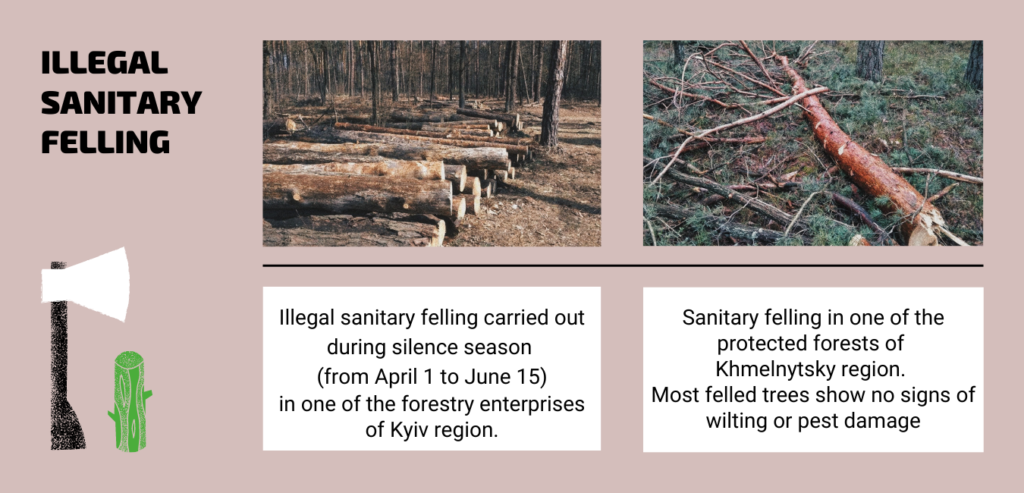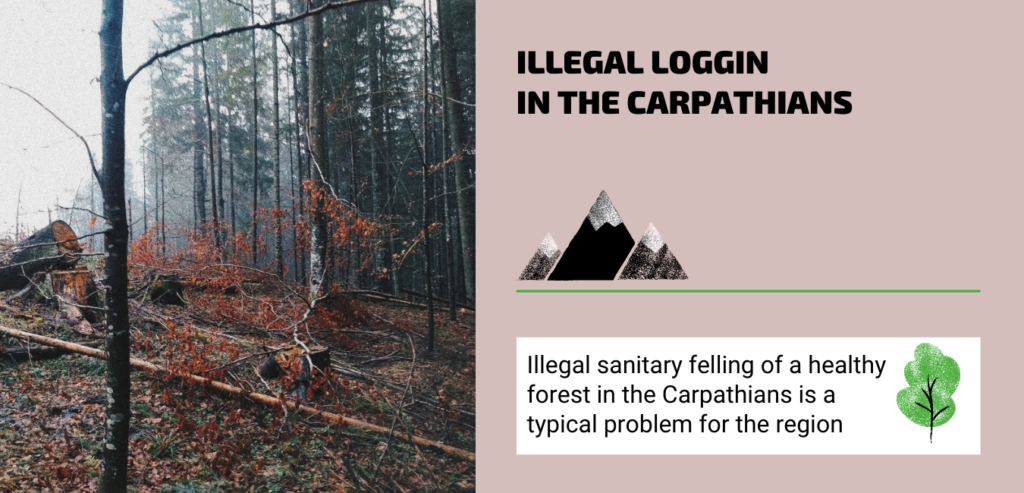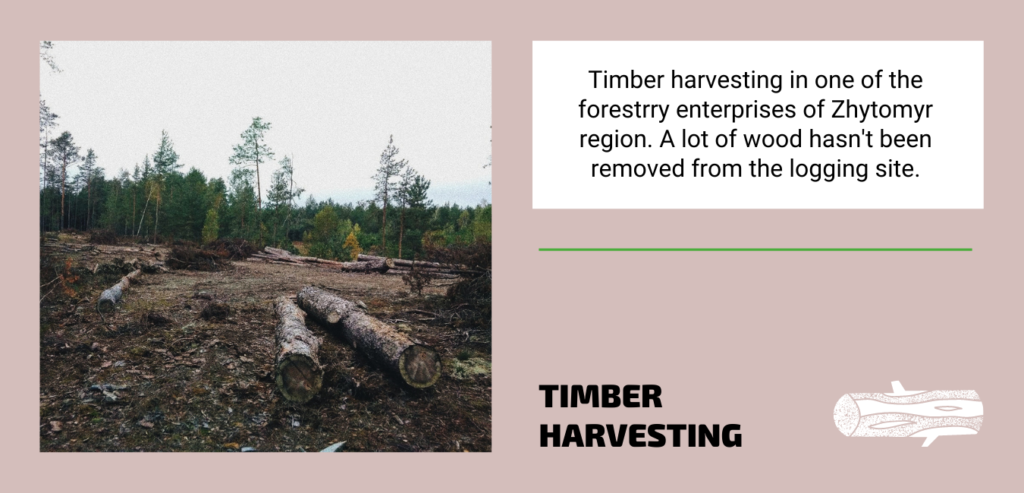On October 26, the Ministry of Environmental Protection and Natural Resources of Ukraine published a draft of the Strategic Plan for State Forest Management of Ukraine until 2035, the main purpose of which, according to the Ministry, is to implement effective forest management based on sustainable forest management, biodiversity conservation of the forestry which would be also adapted to climate change. However, nowadays there are many already existing problems in the forestry of Ukraine, including the problem of illegal logging, which has been widely covered not only in the Ukrainian but also in the foreign media. Ecoclub discussed this and other problems with Yehor Hrynyk, a forestry expert from Kyiv-based NGO Ukrainian Nature Conservation Group (UNCG).
For those who are unfamiliar with the activities of the UNCG, could you briefly tell a few words about its activities?
We are a rather small NGO, which was founded in 2014 by people who, in general, already had considerable experience working in the scientific or environmental sphere. Initially, UNCG was planned more as a community of experts and activists who would cooperate working on various nature conservation projects, and not just as a small organization, which would include 10 people united by a single project.
What exactly do we do? To put it very simply, we work in three main directions. First of all, there is a nature reserve fund of Ukraine and the Emerald Network. Our organization is working on creating new conservation areas and developing the Emerald Network in Ukraine. By the way, we are probably the only ones in Ukraine who work on it quite systematically.
We are also working to ensure that conservation areas in Ukraine are in good condition and really protected not only on paper. The second direction is the steppes and meadows, or the ecosystems called grasslands. Probably every Ukrainian has read Taras Shevchenko’s works, and knows that there is a seemingly endless steppe in Ukraine, but in reality everything has been ruined for a long time, leaving no more than 5% of the historical area of the steppe. In fact, it is a very vulnerable ecosystem, so we are engaged in its protection.
And, the third direction, of course, is Ukrainian forests. We are fighting, or rather trying to fight, corruption in the forestry and working on making it more sustainable. To sum up, the main goal of our NGO is the Ukrainian biodiversity conservation.
Today we will talk specifically about forests. Could you tell the reader, what are the general activities of the UNCG in this direction?
Here, there, and everywhere. First of all, we try to identify certain illegal or semi-legal logging that harm forest biodiversity in any way, and, accordingly, we try to promote and encourage the prosecution of those who carry out such logging. Secondly, we try to work on creating some conservation areas or natural reserves in forests to protect and develop forest biodiversity. Also, for the last year and a half we have been interfering in various processes related to the legal and regulatory frameworks, promoting several draft bills and bylaws that in one way or another relate to forests, actively participating in the EIA, trying to make forest management become more sustainable and pay more attention to forest biodiversity. This is without going into detail.
If I’m not mistaken, there is no specific definition of illegal logging in the laws of Ukraine?
Yes, there is such a problem. Well, in fact there is a definition in the Ukrainian law. I don’t know much about the legal aspects, however, if I’m not mistaken, in 2004 the Plenum of the Supreme Court in one of its decisions clearly stated what illegal logging is. In a nutshell: illegal logging is any logging carried out in violation of applicable laws. But, really, neither in the Criminal Code, nor in the Code of Ukraine about administrative offenses, there is no clear definition of illegal logging. This, of course, causes a huge number of problems.
The problem is that many types of felling are not regulated by law at all, which is often used by state-owned forestry enterprises. For example, one of the types is the so-called reforestation felling, which is especially common in the Carpathians. In Ukrainian legislation there are about five quite abstract paragraphs, which regulate this type of felling, so this allows forestries to use reforestation felling in cases when they aren’t able to conduct another felling type.

There is no official classification existing, but they nominally can be divided into two major categories: felling, which is carried out by the actual state-owned forestry enterprises, and felling, which is not carried out by forestry, and can be called arbitrary.
Arbitrary felling is when, for example, you or I take an ax, go into the woods, and cut down a tree without any documents. In most cases this type of felling appears in court proceedings as illegal. In such a way there is a significant substitution of concepts, which is a big problem. For example, this year Andriy Zabolotsky, the former head of the State Forest Resources Agency of Ukraine, said that during his tenure, the number of illegal logging decreased by 46%. However, the problem is that he did not mean the illegal logging carried out by forestry enterprise, but only these unauthorized felling, i.e. logging that takes place without necessary documents. Of course, if you look at the statistics in this way, you might think that in Ukraine, due to illegal logging, only 118,000 m3 of wood was actually cut down, which would seem to be a relatively small number. But if we really call illegal logging those that are actually such, as they do in European Union, meaning that it is logging with any violations, then the data on the scale of illegal logging will be much larger.
What distinguishes these two categories of felling?
If we compare them, then, of course, a huge quantitative advantage will be on the side of illegal logging carried out by state forestry enterprises. For Ukraine, with few exceptions, arbitrary felling is not a significant problem, in contrast to logging carried out by forestries, which I think is typical of most regions of the country. It is easy to imagine how much forest locals can log without any documents, when in fact they do not need so much wood.
The fact is that most fellings conducted with violations are carried out by those who in theory should carry them out, namely state-owned forestry enterprises. Such logging, especially in foreign publications, is called “illegal logging with documents.” Why so? Most often, forestry enterprises try to legalize such felling and often have a complete set or the biggest part of all the necessary documents. There is a significant number of schemes of illegal logging with documents, I know at least dozens of them, and there are probably hundreds more that actually exist.
Let me give you an example of the most typical scheme, which is very difficult to prove and which is actually common in forestry enterprises almost all over Ukraine. A forestry enterprise conducts a planned felling, having all the necessary documents, and everything seems fine, except for one thing. For example, the forestry is going to cut down 1 hectare of forest, on which there is actually 600 m3 of wood, while in the documents there would be indicated 500 m3. In such a way the felling seems to be legal, but the forestry enterprise will receive 500 m3 of “white” wood and 100 m3 of “black” wood.
Another common example is when a felling should be 1 hectare, but in fact 1.1 hectare of forest is cut down, and the area of initial felling is exceeded by 10%. There are documents for the felling and everything seemingly happens according to the law, but the forestry enterprise obtains 10% of unregistered timber. It is extremely difficult to check the actual area of the felled forest, and no one could do it, as it is necessary to be technically accurate. Another common example: because the raw timber is of different quality, a forestry enterprise can cut down fine timber, and intentionally underestimate the quality of it in the documents, thus obtaining a certain amount of money illegally, bypassing the official accounting.

What determines the quality of wood?
To put it simply, in the primary documentation of forestry enterprises all wood is divided into 3 main categories: industrial wood, semi-industrial and fuel wood. Industrial wood is a kind of fragment of a good trunk without any knots, holes, rot or other defects, which has 6 meters in length. Semi-industrial wood is when the fragment of such a good trunk is from 2 to 6 meters. Fuel wood does not meet the aforementioned requirements and is used for a limited number of needs, one of which is wood-burning. Later, in the documents, industrial and semi-industrial wood is divided into 4 classes: A, B, C and D, where A is the wood of the best quality. In this classification there are a number of technical parameters that determine how the wood is classified.
The above-mentioned schemes which include underestimation of wood quality or unregistered “black” wood belong to more economic and technical violations, but very often felling is carried out in violation of environmental legislation. The violation of environmental laws is an area of interest of our NGO, so we are working mainly in this direction.
Speaking about your activities, what are the typical violations of environmental legislation common in Ukraine?
One of the most typical things that any state-owned forestry enterprise in Ukraine does and that also appears in the Earthsight’s report on IKEA’s illegal timber problem is felling during the silence season. According to our legislation, any sanitary felling during the silence period from April 1 to June 15, is prohibited, however, almost all forestry enterprises in Ukraine don’t care and quietly conduct sanitary felling during this period. At the same time, forestry enterprises do not consider their actions to be anyhow illegal: “how logging could be illegal, when we have a felling ticket for it, together with all the other documents. Well, yes, we broke the silence season, but the felling is still legal”.
Also, many state-owned forestry enterprises ignore the requirements of the EIA, or may not carry out this procedure at all, so as a result it becomes extremely difficult to prove something. Many forestries can cut down forests where threatened species grow, knowing that it would be difficult to prove that this has happened at all due to various “holes” in the Ukrainian legislation. A scheme that is more typical for the Carpathians is when forest enterprises carry out sanitary felling of forests, which in fact does not require any sanitary felling. A completely healthy forest could be cut down, however, the documents would state that it has been destined to die, being affected by all the possible pests, being damaged or dry, but in fact, when you come to this area, you see that the forest is in a perfect state. This is just one example, but in fact, there may be a huge number of similar schemes.
You have mentioned the Earthsight’s investigation which mainly includes cases of illegal sanitary felling. What is the main purpose of this type of felling?
In general, there are different types of felling depending on their purpose. One of the main types, which previously prevailed in Ukraine, is timber harvesting, the goal of which is quite simple – to collect the harvest, and get the high-quality wood, when the forest has grown to a certain age.
However, this is not the only goal, there are many other fellings with different purposes.Forestry officials can issue permits to conduct so-called “sanitary felling” of trees, allowing them to cut the affected trees to maintain the health of the rest of the forest. This type of felling has two main goals. The first is to prevent the spread of any pests in the forest. For example, here are bark beetles that can attack trees. It happens as follows: firstly, a beetle gets under the bark of the tree, lays its eggs there, after what larvae hatch, turn into beetles, the beetles fly out of the bark, migrate to neighboring trees and the whole process is repeated. If the tree has not been able to successfully resist the bark beetle, it is likely to die and begin to rot. If the tree is cut down before the bark beetles begin to fly out of it, their spread through the forest can be prevented.
The second purpose is to have the value of timber. For example, as in the above-mentioned situation with bark beetles, the pests have already entered the tree, laid their larvae there and the tree died, after which the process of its decay began. In this case, the price of such wood begins to fall, so the purpose of sanitary felling is to prevent economic losses and save the tree before it has not yet rotted.
For example, sanitary felling is often carried out where the forest was burning or where it was blown down by the wind, that is, as soon as the forest fell under the influence of wind, it can still be taken out and can still worth something, but in a year or two the wood will rot , and the value of such timber will quickly go down in price. But this is only in theory, in practice everything can be much worse.

Where can such wood be used?
In general, it can be used absolutely anywhere. If this is timber of the lowest quality, it goes to some wood-processing plants, or to the needs of the local population of forested areas, where there is no gasification and people take firewood from forestry enterprises to heat their homes. There is another scheme which has been working for the last few years. Various goods are transported to Ukraine from China in containers that would return empty, so someone has offered a great idea to fill these empty containers not with industrial wood, but with fuel wood. Industrial wood could rot during the long period of transportation, but dry fuel wood would perfectly reach the destination. Thus, a huge amount of fuel wood from Polissya forests is exported to China.
Wood of better quality can be processed both on enterprises in Ukraine and abroad, in particular in the EU, which is probably now one of the main consumers of better quality wood.
Earthsight in its reports mentioned mostly illegal logging in the Carpathians, is it true that most forests are cut down in this region?
No, it’s not true. It is obvious that the Carpathians are not the only forested region of Ukraine. For example, if you took the data from 2019 and compared the volume of felling to forest areas, you would see that in Rivne region they cut even a little more forest than in Transcarpathian region.
Is there any data on the scale of illegal logging in the regions of Ukraine?
This is a very popular question, but I would answer no. Why not? First of all, no one has unanimously decided what exactly illegal logging is in from the legal point of view. There is data on unauthorized felling, which, personally for me, is not very interesting, as their scale in reality is still insignificant. Again, if we are talking about actual illegal logging, it always depends on how we define it. My subjective opinion is that in Ukraine most of the felling carried out by state-owned forestry enterprises is illegal to some extent and is carried out with certain violations, so in each region the data on the scale of illegal logging would be completely different.
Who should control the legality of logging?
In theory, in Ukraine it should be done by two main bodies, one of which is the State Forest Guard. One might think that this is an independent body that deals with forest protection, but in fact the State Forest Guard includes all employees of state-owned forestry enterprises and the entire apparatus of the forest industry. They do have to prevent illegal logging, but it would be very strange if forestry workers caught themselves in illegal logging. There is an obvious conflict of interest in this, so the State Forest Guard is mainly engaged in fighting unauthorized logging, which is not carried out by state-owned forestry enterprises, and does it quite successfully.
The second body that, in theory, should control everything related to forests in general is the State Ecological Inspectorate. It does inspect forestries and is able to detect any violations and illegal logging conducted by state-owned forestry enterprises, but there are a number of problems, including underfunding and lack of qualified staff, as well as related issues that affect most Ukrainian government agencies. Another problem is that the functions of state legislation are very limited. It would be logical to assume that there are some raid teams that could suddenly check the forests, see what is happening there, check the documentation, but in fact the Inspectorate conducts only two types of inspections: scheduled and unscheduled. Any forestry enterprise knows about scheduled inspections a year in advance, while unscheduled inspections can be carried out only at the request of a physical entity. The process of obtaining approval for an unscheduled inspection takes some time, so when the local Environmental Inspectorate finally receives it and goes to the site, it will be too late.
We had a situation when we came to a site where a healthy forest would be cut down by sanitary felling in the Carpathians redion. We wrote about it to the local Environmental Inspectorate, but due to bureaucracy, of course the forestry had already learnt everything, quickly cut down the forest, after which it was almost impossible to record any violations.
Sometimes forestry enterprises may not allow the Environmental Inspectorate on its territory/ In this case they would receive a ridiculous fine, which is much less than the potential losses caused by illegal logging. Even when the Environmental Inspectorate fines the forestry for illegal logging, the amount of the fine is often very insignificant. For example, a forestry enterprise have carried out 100 sanitary fellings during the silence season and received a large amount of illegally logged timber, but the total fine imposed by the Environmental Inspectorate would be around UAH 525, so the enterprise can happily continue cutting down the forest in the future. Moreover, the Environmental Inspectorate can determine the damage from illegal logging, the amount of which will be much higher than the fines, but, as a rule, this applies only to unauthorized felling.
And, of course, very often there is a problem of corruption, which together with incompetence leads to the fact that the Environmental Inspectorate, unfortunately, very rarely records the violations. By the way, as far as I know, the Verkhovna Rada now has a draft bill on environmental control, which should, in theory, expand the power and authority of the Environmental Inspectorate and give it the opportunity to conduct unannounced unplanned inspections, but, unfortunately, this is not yet the case.

What about legality and sustainability certificates, such FSC, are there any problems with such certification in Ukraine?
The problem is one, and quite big – certification in Ukraine does not work. FSC certification has been operating in Ukraine for 20 years, and nowadays they are implementing another alternative PEFC certification system. Their essence is the same: back in the 1990s a number of environmental and wood-processing organizations cooperated and decided that the legislation of many countries in this industry are not very good, so they would create their own standards of forestry. To put it simply, the idea is that any forestry will be able to call FSC auditors to inspect its enterprise, and if it is in compliance with the FSC standards. If the audit is successful, the enterprise will obtain some market advantages, as they will be able to affix the FSC logo to its products, which will mean that a conscious buyer somewhere in a well-developed country, would buy their products with this FSC-label, being sure that the product is environmentally friendly and legal. Оne more detail, not only enterprises who log wood are certified, but also the ones which then are engaged in its realization or processing. Companies which buy and process wood from certified forests need to obtain a ‘Chain of Custody’ (CoC) certificate proving that they can avoid mixing it with other wood.
How it works in reality: there is actually the FSC organization itself, which only coordinates the whole process, writes standards and rules, and there are approved certifiers – profit-making auditing firms, which carry out all the assessments. In Ukraine, there are three such auditing firms, which in theory operate independently of both forestries and FSC offices, and which annually inspect forestries for compliance with certification standards. The problem is that the work of these secertifier, who are mostly foresters themselves, is paid for by the forestry itself, so I don’t think it’s hard to guess what it all leads to. In Ukraine, about 45% of forests are certified, but a large number of scandals related to illegal logging take place in the certified forests.
Do problems with FSC occur only in Ukraine?
There are a lot of problems with FSC which arise not only in Ukraine. The FSC office in most countries is burying its head in the sand. Even recently after the publication of the latest Earthsight’s investigation: for some reason, all the media wrote that IKEA is bad because it buys illegal timber. In fact, if you compare IKEA with many other companies that are somehow related to the wood industry, it seems to me that IKEA is still one of the best examples. The problem is that IKEA relies heavily on this certification, which does not live up to expectations. Moreover, the FSC certificate is one of the ways how Ukrainian wood can easily enter the foreign market. European companies importing timber from Ukraine have to check its legality, so having an FSC certificate is always a significant advantage, no matter that such timber can be both legal and illegal. In conclusion, the FSC certificate does not indicate anything and does not work as it should in theory.
Apart from certificates, what are other ways to export Ukrainian wood abroad?
Basically, most wood is exported quite legally, along with all the necessary documents. As far as I know, in order to export timber, the exporter, often the forestry enterprise itself, or an intermediary, must have a certificate of origin stating who felled the timber, where and on what grounds. Such certificates, in fact, foresters issue themselves. There has recently appeared an interesting analytical portal, which contains a lot of data on both felling and export. We have not studied it in detail, but only a brief look and comparing data from the portal and documents of some Carpathian forestry enterprises, showed cases when better quality wood was exported being indicated in the documents as belonging to lower quality.
In your opinion, are there any positive changes in Ukraine in the fight against such illegal logging schemes?
As I have already mentioned a good bill on environmental control, which was developed by our colleagues from EPL, but it is still in a suspended state, as there is a strong lobby against its adoption by those who do not like the idea of the existence of a properly functioning environmental control. As far as I know, in the last few months the Ministry of Environmental Protection and Natural Resources has finally started to make positive changes, for example there is an initiative to close the “holes” with illegal and semi-legal logging used by forestry enterprises. Unfortunately, it’s all just good intentions, and I do not see any real achievements yet. The problem is that this applies not only to illegal logging, but also to the lack of normal application of the law in Ukraine in general. Cases of illegal logging highlighted by public organizations may lay for years somewhere at the stage of pre-trial investigation, or may not actually be interesting to anyone, unfortunately.

Speaking about your activities and the activities of the Ukrainian Environmental Сonservation Group (UNCG) in general, what do you consider your greatest achievement?
Hmm, it’s a good question. It seems to me that sometimes it is difficult to understand what is our own achievement and what is not, in cases where several organizations are working on a common cause. I think we have made a contribution to push the ministry a little bit to finally start modernizing the regulatory framework. If very subjectively, the achievement for me is that last year we, together with colleagues from other organizations in cooperation with the Ministry of Environmental Protection, managed to develop a methodology for conducting EIA in forestry, which now officially exists and is approved by the Ministry. I will not say that so far it has given significant results, but I hope that one day it will function properly. We also have some good local success stories related to particular forestry enterprises.
The UNCG is also developing a network of protected areas, such as the Emerald Network, and currently about 13% of Ukraine’s territory is a part of it, much of which was made thanks to the work of my colleagues from the organization.
Are your activities, especially those related to illegal logging, one way or another related to risks, have you ever had unpleasant incidents, intimidation, or lawsuits?
There were threats of a lawsuit, but the case did not reach the court itself. Personally, I had various unpleasant confrontations with foresters, especially for some reason it often happened in the Carpathians, when foresters together with locals threatened us verbally, tried not to let us into the forest and so on. But it was not critical, they just shouted and got away. There were similar situations in the forestry in Odesa region, when representatives of the regional council and administration threatened activists to block the Odessa highway, and visit and destroy our office in Vasylkiv, but all this remains on the level of verbal intimidation. My colleagues who deal with the EIA are also periodically called and told how they are wrong and how they should be “right”, but it’s all no more than threats.
The problem is that to be a popular activist is quite simple, especially if you work in a NGO that covers its work in the media. But if you are a regional activist, especially rather unknown to people, of course the situation can change, up to censorship, physical violence or social ostracism.
What would you recommend to read to people who are interested in the topic of illegal logging? And how can they get involved in forest protection?
There are many publications on this topic, including the same well-known Earthsight’s reports, that can give someone a general idea of how illegal logging takes place in Ukraine. There is also a good publication from 2010, a kind of report on illegal logging in Ukraine, which, unfortunately, is still relevant. The second question is more complicated. First of all, in order to understand that logging is illegal, you need to know the laws quite well. So if you want to make forest protection your kind of volunteer or activist hobby, you should probably start with this.
We also periodically release our own publications and other materials on the topic. For example, we are currently working on an online course on forest protection, which will include some legal and environmental aspects, so we hope to release it soon and cover this topic in layperson’s terms.

- You can learn more about the Ukrainian Conservation Group (UNCG) and support their environmental activities on their website: http://uncg.org.ua/pidtrymaty/
- You can support the creation of new publications and the activities of Ecoclub by clicking on the button at the top of the menu: “Donate – Charitable contribution”.
- The photos used in the publication are taken from the own archive of Yehor Hrynyk.











